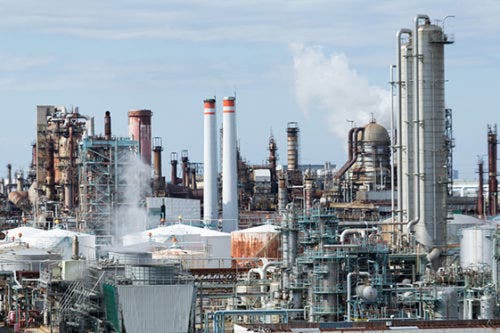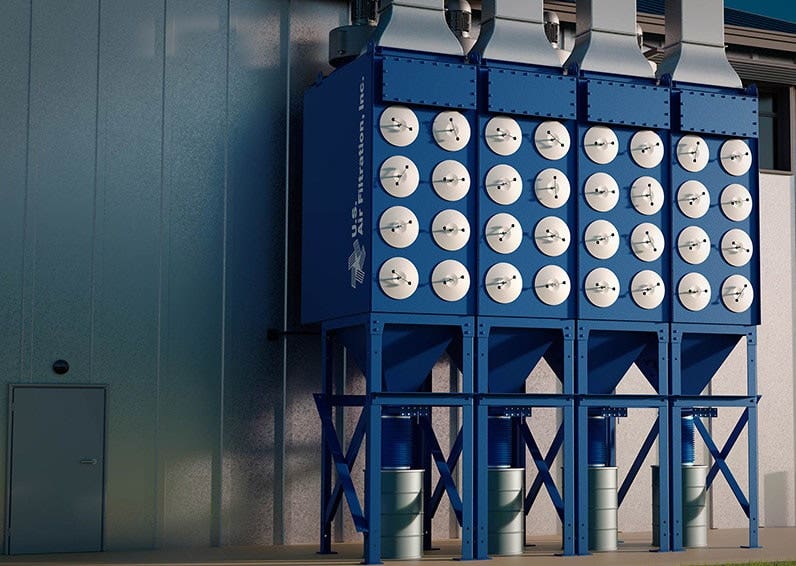Choosing the Right Dust Collection System
There are two common approaches for using cyclone dust collectors, as a stand-alone system or as a pre-filtration unit paired with a larger dust collector. This article includes information on:
- How cyclones work
- The benefits and disadvantages of a standalone cyclone
- Common applications, and the advantages of a combination cyclone and baghouse or cartridge dust collection system.
Understanding these variables can help you identify whether a standalone cyclone system is best for your application or if you need to pair your cyclone with a larger dust collection system.
How Does a Cyclone Dust Collector Work?
Cyclone dust collectors are small-scale stand-alone units that work to remove large dust particulates from the air using centrifugal force. The filtration process starts with dirty air being drawn into the cyclone dust collection system at a high speed. This high-speed motion works as a controlled “hurricane” inside of the cyclone. The “hurricane” motion allows larger particles to be pushed out and up against the cyclone walls. Then once the dirty air hits the walls of a cyclone, momentum slows down, which is enough to permit larger particles to drop out of the airstream and into a hopper beneath.
Dust Characteristics, Capacity, CFM, and Cyclone Dust Collectors
Understanding your Dust characteristics is the first step to understanding whether you need a baghouse, cyclone or both?
Cyclone dust collectors are ideal for applications dealing with large, coarse dust particulate. If your application contains a mixture of large and small dust particulate, you’ll likely need tofilter larger dust particulate out first with a cyclone and then direct the remaining gas stream to a larger baghouse that uses filters to handle finer particulate. This two-step filtration process helps prevent large particulate (e.g., wood chips) from creating unnecessary wear and tear on baghouse filters.
Beyond dust characteristics, dust loading rates and CFM are factors when considering which dust collection system is best for a specific application. Because cyclone dust collectors are small-scale units, their capacity to handle dust particulate is finite. General dust loading rates can be between a 5-to-30-gallon drum. In terms of CFM, most cyclones operate anywhere around 1000 CFM or below.

Common Applications for Cyclone Dust Collectors
Applications for Stand-Alone Cyclones:
- Woodworking applications with only large dust particulate
- Agricultural applications with only large dust particulate
Applications for a Baghouse or Baghouse and Cyclone System:
- Woodworking (all)
- Agricultural (all)
- Mining & Minerals
- Recycling
- Pharmaceuticals
- Paper Products
- Chemicals
- Rubber Plants
- Food Manufacturing
- Bulk Powder
- Industrial Equipment and Machinery
- And More!

Advantages and Disadvantages of a Cyclone Dust Collector
Cyclone dust collectors are designed as a simple steel structure with no moving parts or filters. Because of this simplicity, the main advantages and disadvantages are:
Advantages of a Cyclone:
- Low up-front investment. There are a wide variety of models, but generally you can find a cyclone dust collection system ranges anywhere from $500-$3000.
- Long-term cost savings on maintenance and repair
- Paired with a larger baghouse, can increase the efficiency and life of filter bags or cartridges
Disadvantages of a Cyclone:
- Low dust loading rates
- Limited CFM capabilities
- Low efficiency at capturing fine particulate
- Unable to process sticky materials
- Application use is limited
Benefits of a Cyclone with a Baghouse Dust Collection System
In specific cases, an engineer may determine that your plant can benefit from pairing a cyclone with a larger dust collection system. Typically, processes that have a mix of large and small particulate are the ideal candidates for this type of setup.
A cyclone could be implemented as a pre-filtration system to eliminate any large, coarse particles that could damage a dust collector’s filter bags or cartridges further downstream. The result is an increase in the performance of a dust collection system and the service life of the baghouse filters. In certain cases, cyclones can also help to reduce dust loading into a baghouse with a high inlet entry. This method reduces internal velocities (e.g., can velocity) resulting in improved efficiency and increased filter life.
To determine whether your application would benefit from a combination cyclone and larger dust collection system, some questions you may be asked include:
Questions to Consider:
- Do you have a dust analysis or DHA (dust hazard analysis)?
- What’s the size of your particulate? Is it big? Small? Mixed?
- How much dust are you filtering out in a given work shift?
- Could your dust collection design incorporate an end inlet as an alternative? While there is no cyclonic action with an end inlet, the attributes are similar. An end inlet helps bring in the dust high, but as it hits a baffle, it redirects the air directly downward. In this scenario, heavy particulate hits the baffle, then slows down and drops out. Then rest of the air is kicked down below the bag, allowing your system to still have can velocity. The disadvantage to an end inlet is these types of baghouses tend to be considerably larger because there must be space for air to hit the baffle.
Even in similar industries, plants will have different requirements and variables from one another that will determine the right dust collection solution. To get beyond the basics, we recommend speaking to an engineer who can help with your specific application and needs.
Conclusion
To summarize, cyclones are limited in their capabilities. In certain conditions you could add a cyclone to be helpful and reduce dust loading on larger systems, but cyclones alone are not typically adequate for most industrial applications. At U.S. Air Filtration our engineers can help determine if the dust collection system you’re looking for would benefit from adding a cyclone. Our goal is to do what we can do to help save you costs, while also ensuring we are designing a solution that will perform long term.







